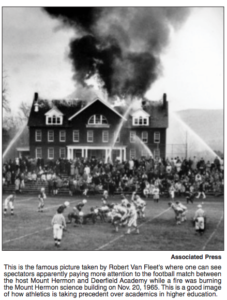College Sports Remain a Source of Controversy

Every year we hear about scandals related to college sports. Whether it is under-the-table payoffs to “amateur” athletes, academic cheating, or overpaid coaches, the fact of the matter is that these stories remind us of the movie “Groundhog Day” in which its main protagonist -portrayed by Bill Murraywakes up every day to relive the same events and no matter what he tries to do to change them, they never do.
A book published last year titled, “The Athletic Trap: How College Sports Corrupted the Academy” by Howard L. Nixon II, provides some very good insights about what is going on with college sports. Nixon is a sports sociologist who has been a faculty member and administrator at the University of Vermont, Appalachian State University and Towson University.
Among the facts we learn from his book are that recruited athletes are becoming a larger percentage of the student population at many institutions of higher education, including liberal arts colleges. Since these students receive financial aid that, of course, means that other deserving students don’t.
By the same token, student athletes enjoy a significant admission advantage, which is detrimental to students who are better academically prepared for college. It has been shown that many recruited athletes have substantially lower SATs than other applicants.
Not surprisingly, they obtain lower grades than others, even in seasons when they do not participate in sports events. These student athletes, who usually elect to major in the social sciences and business, spend large amounts of time together, leading to an athletic “culture” and lack of integration into other activities of campus life.
Nixon proposes several actions to eliminate these problems, such as reducing the number of athletic recruitments by adjusting the admissions criteria and providing more monitoring. He also proposes that coaches must be recruited based on their performance as teachers and campus citizens, that time commitment to varsity athletics be shortened, even that athletic programs be eliminated altogether. Good luck with that.
The major problem is a cultural one.
Despite major financial constraints that institutions of higher education are going through (particularly public ones), one rarely if ever hears of cutting or eliminating athletic programs to stop this bloodletting of financial resources. One argument used is that these athletic programs bring money and prestige to the institution. The problem is that very few college athletic programs in the country are not in the red and the ways their financial statements are presented tend to be misleading by not counting all the actual costs of carrying out those programs.
Community leaders are major influencers in keeping college athletics in business. They oftentimes see postsecondary institutions as sources for local “entertainment” and as a source of business for the hospitality sector that provides services for visitors coming to watch sporting events. In turn, this generates an escalating competition among these institutions modeled after private corporate commercial interests.
In the interim these interests cloud the vision of university leaders (including their governing boards) in a number of areas that tend to be overlooked. One of them is students’ health. More and more we hear of the effect of concussions, particularly when it comes to football players. But the biggest one has to do with the very mission of higher education. If its mission is to education, why do these institutions want to be known for their athletic programs? After all, the number of college students who become professional athletes is miniscule. If preparing students for sports careers is the mission of colleges and universities, then they are failing miserably.
What this shows is the inability of college leaders to explain why higher education matters and how transformative that experience is in so many individual and societal areas. This has been the result of having an increasing number of college executives and board members who lack strong academic experience. They lack the preparation and the imagination to promote what their institutions are really for: producing quality graduates and positively impacting society through their scholarship.
College leaders should explain why coaches are better paid than themselves. After all, this imbalance in compensation is one of society’s true oxymorons. Further, they should also explain that if their institutions claim to financially benefit so greatly from athletics, why are they not paying those athletes for their work and talent? Maybe because that would be the final admission that their athletic programs have no place in an educational institution but that they are rather a commercial operation. One gets mesmerized seeing these “amateur” athletes playing before crowds of up to 100,000 and broadcast via national television.
That is why the problem with athletic programs in higher education is a cultural one. Case in point was the sexual child abuse scandal at Penn State University being covered up at all levels of university administration. That is not why a university should be known.
Unless our college leaders stop being blinded but the alleged “aura” of athletics, they will continue to fall into the athletic trap. After all, there is no worse combination than money, lack of moral fiber and ignorance of the real mission of higher education
PDF Version
College Sports Remain A Source Of Controversy